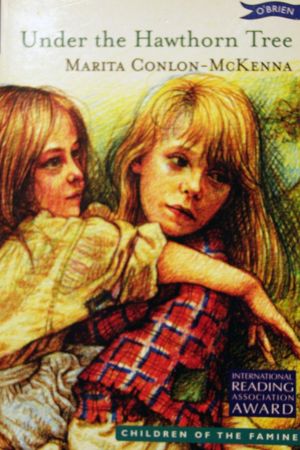
About the Book
-
Author:
- Marita Conlon-McKenna
Cover Story: Brown Bag It
Adoption Certificate: Yes!
Swoonworthy Scale: 0
Talky Talk: Patchy
Bonus Factors: Ireland, Great Aunts
Relationship Status: Surprise Reunion
Cover Story: Brown Bag It
Given that this is a middle grade, historical fiction novel, the cover kind of makes sense. But yeah, not a chance of tricking ANYONE into thinking this is a grown-up book. Plus, something about Peggy’s cartoonishly giant eyes reminds me of the descriptions of the twins in Flowers in the Attic, which is never a good mental association.
The Deal
Eily, Peggy, and Michael are struggling through the Irish potato blight. A few weeks ago, their father went off to work on the roads for a little income, but he hasn’t come back since. Baby sister Bridget just died of the fever, and their mother has set off to find their father. But when she doesn’t come back either, the children are faced with going off to the workhouses or trying to run away to some unknown relatives on the other side of the country. Will they manage to survive the journey through the wilds of Ireland, surrounded by famine, disease, and death?
But really, here are the salient details: I LOVED this book growing up, and had completely forgotten about it until I stumbled into a used bookstore in Northern Ireland a few weeks ago. And there it was! I think my great aunt in Ireland must have sent me these books growing up, and I have forever associated historical fiction with Conlon-McKenna. Can it stand the tests of time?
Adoption Certificate: Yes!

V.C. Andrews, take note. THIS is how you write sad, starving children. Your whiny, irritating, unsympathetic characters can’t hold a candle to the O’Driscolls. When they are whiny, it’s because they are actively dying. The rest of the time, they are resourceful, intelligent, brave little kids who are just desperate to survive the famine with the remainder of their family intact. I would gladly adopt them.
Swoonworthy Scale: 0
This is a book about some siblings trying not to starve to death. No.
Talky Talk: Patchy
This is Conlon-McKenna’s first book, so I’m guessing she smoothed out her writing in later years. But here, it’s a little hit or miss. Sometimes I felt like I was reading The Boxcar Children with the stilted, choppy dialogue and weird, semi-omniscient narrative. For instance,
Mother stopped. Three soft little faces were turned to her. She swallowed a lump in her throat. Would her little ones ever know such times? Their lives were so hard.
Yikes. That’s… not very good. I realize this is a middle grade book, so things tend to be spelled out a little more than what I’m used to. But seriously, your readers are children, not idiots. Kids are smart, yo. They deserve good writing too! By contrast, other parts of the book get really, alarmingly dark for the target audience:
He could feel a pain in his chest and knew that his heart was broken in two and his childhood gone forever. He slowed down, he had a long and miserable way to go. There was no God, and if there was he was a monster.
The writing is still not my favorite, but whoa. Those are some deep questions about innocence and religion for little kids. Questions that are definitely not resolved by the end of the book. She just tosses them in there amongst the relatively bland, didactic writing style and is like, “Here children! Just let that marinate.” I’m not saying that there aren’t kids mature enough to start thinking about those questions, but it’s a pretty odd juxtaposition.
Bonus Factor: Ireland

YAY IRELAND! I mean, 1845 is not the most cheerful year we could pick, but all the same, Ireland! And the Great Famine is an interesting, if depressing, backdrop for the story. I actually like that Conlon-McKenna didn’t spend a lot of time examining causes of the famine. From a little kid’s perspective, they would just understand the hunger and the death and not the complex socio-political factors (read: England being a bag of dicks, also fuck you Adam Smith and your self-correcting markets) that exacerbated the problem. But reading as an adult with more context, there are little details, presented largely without comment, that paint a more complete picture – things like the wealthy landlord returning to England while the tenants are kicked of the land, or a brief scene where there’s a riot over some grain that’s being shipped to England. Younger readers probably wouldn’t pick up on the significance of these, but it’s nice that they’re there.
Bonus Factor: Great Aunts

At the start of the book, the O’Driscoll children set out of find their Great Aunts Lena and Nano. The children have never met said aunts, but they represent this wondrous, apocryphal possibility that the kids will arrive at their destination, be fed scones and jam, and lovingly tucked into bed. Based on personal experience, this is exactly what Irish great aunts should do. I used to live with one when I was little, and GIMME MY SCONES AND JAM NOW! Nom nom nom.
Relationship Status: Surprise Reunion
When I stepped into that bookstore in Derry, I never would have guessed that I’d run into an old friend there. I hadn’t given this book a second though in about fifteen years, but I was pleasantly surprised to see it there. We quickly became reacquainted over tea, reminiscing about times passed, and then we both went on our separate ways again. Who knows, maybe we’ll have another chance encounter 15 years from now! Only time will tell.
FTC Full Disclosure: I received neither money nor cocktails for writing this review (dammit!). Under the Hawthorn Tree is available now.